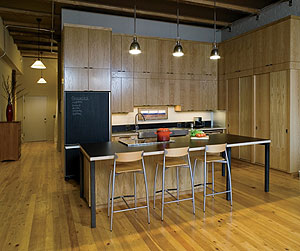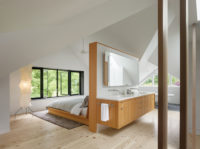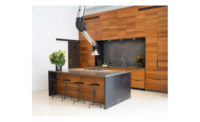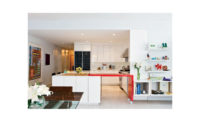R'm Architecture Studio
Seattle, Washington
Carol Sundstrom, AIA, describes Randy Earle and Leslie Haynes as a design savvy couple who love to cook and entertain. “They’re major foodies,” says the Röm Architecture Studio principal. “Functionality was thus very important.” Especially since the kitchen, like the rest of the couple’s Seattle loft, had to be wheelchair friendly; a degenerative condition affects Earle’s mobility. The renovation, a collaboration with accessibility consultant Karen Braitmayer, FAIA, proves universal design is not a one-size-fits-all proposition. “The space is very specifically tailored to how Randy cooks and moves,” says Sundstrom.

General contractor
Thomas Jacobson Construction
Accessibility consultant
Karen Braitmayer, FAIA
Sources
Precision Custom Kitchens (cabinets); Formica (counter laminate); Kollmar Sheet Metal (sink); Axor (faucet); Wolf (cooktop); Sub-Zero (refrigerator); Fisher & Paykel (dishwasher)
The loft’s industrial bones and pine flooring inspired the kitchen’s white-oak millwork and blackened steel details. Tall cabinets take full advantage of the 12.5-foot ceiling height; infrequently used items are on topmost shelves while cooking equipment is within reach from a seated position. “We made tons of measurements: the distance from lap to floor, eye to floor, even how far forward Randy—who’s quite tall—can bend when sitting,” notes Sundstrom. Prior to renovation, the clients also made copious notes to determine the ideal placement of various elements, such as counter height and appliance adjacency.
The laminate counters are 34 inches, a height dictated by the placement of stacked dishwasher drawers. “We wanted a continuous datum line, minus the ups and downs that distinguish accessible kitchens,” Sundstrom explains. A shallow, 8-inch-deep stainless-steel sink was customized to accommodate Earle’s wheelchair; the garbage disposal is relegated to the back corner for ample legroom. The single-handle faucet sits to one side so it can be easily grasped, which is also the idea behind hooked drawer pulls and the island’s steel grab bars. Turning radius was important, too: Cabinet doors on the side wall slide rather than pull out, and a generous 4 feet separates counter and island.
Safety features include cool-to-the-touch induction burners and a trolley that rolls from below the appliance garage to help maneuver dishes from oven to table—which, after all, is what the space is about. “Kitchen design is evolving from the classic triangle to multiple workstations, which better support how cooks work,” Sundstrom explains. “Everything is more focused onergonomics.”





Post a comment to this article
Report Abusive Comment